
Heating, ventilation, and air conditioning (HVAC) is the use of various technologies to control the temperature, humidity, and purity of the air in an enclosed space. Its goal is to provide thermal comfort and acceptable indoor air quality. HVAC system design is a subdiscipline of mechanical engineering, based on the principles of thermodynamics, fluid mechanics, and heat transfer. "Refrigeration" is sometimes added to the field's abbreviation as HVAC&R or HVACR, or "ventilation" is dropped, as in HACR.
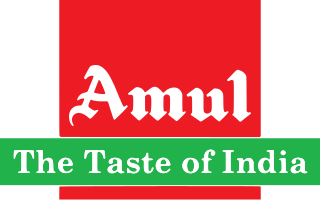
Anand Milk Union Limited is a acronym of the Indian state government owned dairy based cooperative society named Gujarat Milk Marketing Federation based in Anand, Gujarat. It is under the ownership of Gujarat Cooperative Milk Marketing Federation Limited, Department of Cooperation, Government of Gujarat. It is controlled by 3.6 million milk producers within the city.

Mehsana, also spelled Mahesana, is a city and municipality in Mehsana district, in the Indian state of Gujarat. Established in 14th century, the city was under Gaekwads of Baroda State from 18th century to the independence of India in 1947. The municipality was established in 1919–20. The town has population of about 185,000. Dairy, oil and natural gas are major industries while there are several small and medium enterprises in the city.
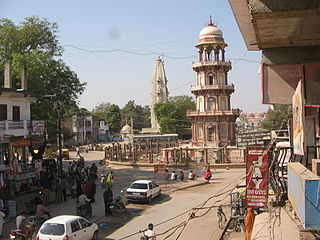
Banaskantha district is one of the thirty-three districts of the Gujarat state of India. The administrative headquarters of the district is at Palanpur which is also its largest city. The district is located in the Northeast of Gujarat and is presumably named after the West Banas River which runs through the valley between Mount Abu and Aravalli Range, flowing to the plains of Gujarat in this region and towards the Rann of Kutch. The district is famous for the Ambaji temple which draws many tourists. It covers an area of 12703 km2 and is the second largest district in the state.

The Queen Elizabeth Hall (QEH) is a music venue on the South Bank in London, England, that hosts classical, jazz, and avant-garde music, talks and dance performances. It was opened in 1967, with a concert conducted by Benjamin Britten.
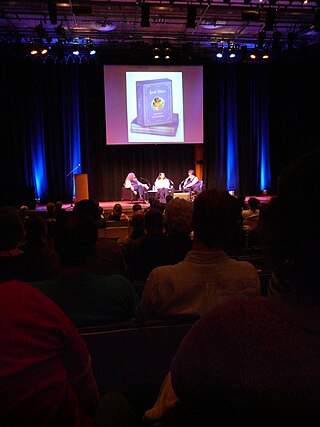
The Purcell Room is a concert and performance venue which forms part of the Southbank Centre, one of central London's leading cultural complexes. It is named after the 17th century English composer Henry Purcell and has 370 seats. The Purcell Room has hosted a wide range of chamber music, jazz, mime and poetry recitals. In the context of the Southbank Centre it is the smallest of a set of three venues, the other two being the Royal Festival Hall, a large symphony hall, and the Queen Elizabeth Hall (QEH), which is used for orchestral, chamber and contemporary amplified music.
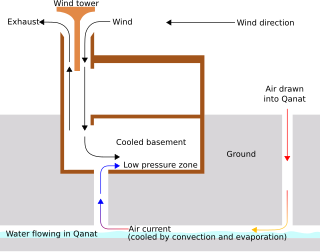
Passive cooling is a building design approach that focuses on heat gain control and heat dissipation in a building in order to improve the indoor thermal comfort with low or no energy consumption. This approach works either by preventing heat from entering the interior or by removing heat from the building.

The Ahmedabad Textile Industry's Research Association is an autonomous non-profit association for textile research located in the Navarangpura area of Ahmedabad, India. It is the largest association for textile research and allied industries in India. Established on 13 December 1947, and started in 1949, ATIRA was recognized by the Council of Scientific and Industrial Research under the Ministry of Science and Technology, Government of India. It was later linked to the Ministry of Textiles.

Ganpat University (GUNI) is a private university in Kherva, Mehsana in the state of Gujarat, India. It was established in 2005 through the State Legislative act no 19 of 2005, Government of Gujarat, and recognized by the UGC under the section 2(f) of the UGC Act, 1956 having campus spread over more than 300 acres of land and more than 10,000 students on campus.

Achyut Purushottam Kanvinde was an Indian architect who worked in functionalist approaches with elements of Brutalist architecture. He received the Padma Shri in 1974.
Unava is a village located near Unjha, in Mehsana district of Gujarat, India. It is on the SH41 (Mehsana-Palanpur). Unava is about 40 km from Palanpur if visitor is coming via Rajasthan and 90 km from Ahmedabad via Maharashtra route.

Saldi is a village in the Mehsana District, Gujarat, India, Pin Code 382730, situated on State Highway 217 between Gandhinagar and Mehsana. Saldi represents a typical countryside village of India. It borders the following villages: langhnaj, Veda, Parsa, Charadu, Vadasma, Shankarpura, Khata Amba, Khoraj and Himatpura. Saldi is famous for its temple of Pimpleshwar Mahadev, about 1 kilometre from the Saldi town square.
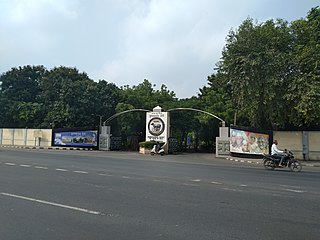
The Mehsana District Cooperative Milk Producers' Union Limited, popularly known as Dudhsagar Dairy, is a division of Gujarat Cooperative Milk Marketing Federation which is under the ownership of Ministry of Cooperation of the Government of Gujarat.

Banas Dairy is a division of Gujarat Cooperative Milk Marketing Federation which is under the ownership of Ministry of Cooperation, Government of Gujarat based in the Banaskantha district of Gujarat, India and is Asia's largest milk producer. It was founded in 1969, in accordance with the 1961 rule of the National Dairy Development Board under Operation Flood. Galbabhai Nanjibhai Patel played an important role in the foundation of the dairy. It is headquartered at Palanpur.

South Burnett Co-operative Dairy Association Factory is a heritage-listed former factory at Macalister Street, Murgon, South Burnett Region, Queensland, Australia. It was designed by George Gerald Hutton and built in 1929 by H Taylor. It was added to the Queensland Heritage Register on 9 November 2012.
The Architecture of Gujarat consists of architecture in the Indian state of Gujarat.

Rajmahal is a palace in Mehsana, Gujarat, India. Built in 1904 by Sayajirao Gaekwad III of Baroda State, it was used as the government office and later as the court until 2017. It has three floors and 130 rooms.

Budd Dairy Food Hall is a food hall in the Italian Village neighborhood of Columbus, Ohio. The Cameron Mitchell Restaurants-run hall holds ten foodservice locations, three bars, and indoor, patio, and rooftop seating. It is situated in the historic Budd Dairy Company building, a former milk processing and distribution facility. The space was renovated beginning in 2018, and opened in April 2021.
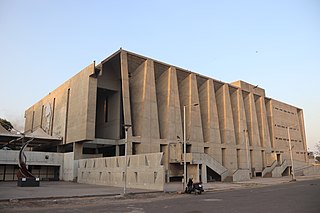
Tagore Memorial Hall, also known as Tagore Hall, is an auditorium in Ahmedabad, India. It is designed by B. V. Doshi in 1961. It is an example of brutalist architecture. Construction started in 1966 and was completed in 1971. It was renovated in 2013.
Narendra Dengle is an architect, academician, and author based in Pune. His architectural designs have been a part of VISTARA in Paris as part of the Festival of India exhibition in 1986, and State of Architecture Exhibition in Mumbai in 2017-18. He has partnered and worked on various academic and architectural projects with Achyut Kanvinde, Vasanth Kamath, Romi Khosla, M.N. Ashish Ganju, and Kamu Iyer.


















